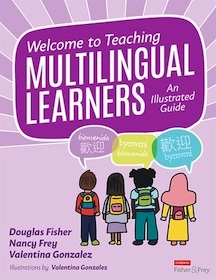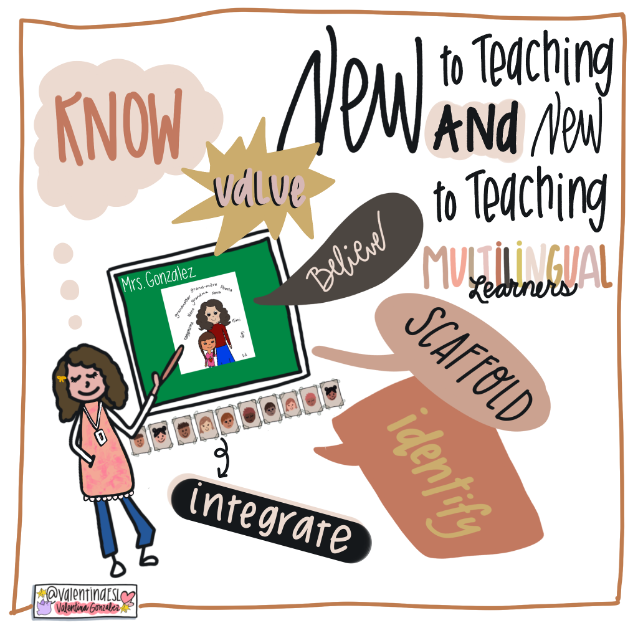New to Teaching and to Teaching MLs? Try This!
By Valentina Gonzalez
 A large wave of new teachers stepped into classrooms for the first time ever this year. You may be one of them. And if you are, let me thank you for entering one of the most important careers in the world.
A large wave of new teachers stepped into classrooms for the first time ever this year. You may be one of them. And if you are, let me thank you for entering one of the most important careers in the world.
As educators, we have the honor to serve young minds. You will find that the students in your care are vastly unique. Multilingual learners (MLs) are one special group of unique minds you’ll encounter.
Multilingual learners are students who speak or hear a language other than English at home. These students are sometimes called English language learners, English learners, or emergent bilinguals.
I like to think of them as “future global leaders.” These unique students continue to be one of the nation’s fastest-growing groups, making up about 10% of the total student population in the United States. And in some states, like California and Texas, the numbers are well beyond 10%.
It’s very likely that you have a multilingual learner in your classroom or soon will. Here’s what you need to know and how you can begin supporting multilingual learners for success in your classroom and beyond.
1. Believe.
Start by believing that multilingualism is an asset. Approaching our students with an assets-based mindset is important. Think about how adult bilinguals or multilinguals are perceived. Often they enjoy higher pay and are admired for their ability to communicate with more people. If we embrace the beauty of multilingualism and recognize it as a gift, students will feel affirmed and valued for who they are.
2. Identify.
States have different ways of identifying MLs upon their enrollment. You will need to find out who the multilingual learners are in your classroom. Knowing this will help you plan linguistic (language) support for MLs. The linguistic supports or accommodations (see #4) that MLs need vary and are often determined by language proficiency levels. If you are unsure about your list of MLs, reach out to the EL specialist or an administrator on your campus and ask for a list.
3. Know.
Get to know as much as you can about the MLs under your care and their families. Beyond the permanent record folder, learn about their family life, their hobbies, their culture, their goals, etc. Avoid making assumptions about MLs and their families and instead reach out to them, ask, and most of all listen. In addition, find out about the student’s language proficiency in English and in their home language. Can they read and write in English? Can they read and write in their home language?
4. Value.
Research has demonstrated that first language is valuable to second language acquisition. Invite and encourage students to use their first language. Some students don’t recognize the value of bilingualism or multilingualism until they are older. Many share that they are embarrassed by their home language, especially in the middle grades.
Creating a classroom and a campus culture that invites, validates, and celebrates all languages helps every student see languages as assets and ways to communicate. It’s one thing to say we value all languages, but it’s another to quantify the statement.
Here are a few ways to demonstrate valuing and affirmation of all languages:
• Add posters in multiple languages on the walls
• Include signs and labels in languages other than English
• Provide books in many languages for students to read
• Listen to students read in languages other than English
• Encourage students to write in languages other than English
• Invite students to speak in languages other than English
5. Scaffold.
Offering multilingual learners your highest quality teaching is essential. They may need linguistic support to comprehend instruction. Rather than watering down the curriculum or providing menial tasks, give MLs support that helps them achieve grade-level standards.
Ensuring that instruction is comprehensible or understandable is a top priority. If MLs don’t understand the initial lesson or what they hear or read in school, then it’s not likely they will do well on the formative or summative assessments.

It is likely, however, that they will be left feeling lost, confused, frustrated, and undervalued. Over time, these feelings can manifest into misbehavior. And over time, we run the risk of creating long-term English learners, a problem that is serious for our MLs and may cause students to drop out or put them in danger of not graduating with their peers.
For examples of scaffolds and what this type of high-quality instruction might look like in the classroom, read more here.
6. Integrate.
Prepare lessons that integrate language with content. Neither one is more important than the other. No matter a student’s English proficiency, they need to have access to academic content and grade-level standards.
As we design the delivery of the curriculum, we can deliberately plan opportunities for students to listen, speak, read, and write in all content areas. MLs in classrooms are learning content while acquiring English. It is important that we not only make content available, but make sure the content is accessible.
Supporting MLs on Their Education Journeys
Multilingual learners are capable and valuable. They can do amazing things in our classrooms and our communities. Don’t be afraid or intimidated by the challenge. Many teachers share that they learn more from multilingual learners than multilingual learners learn from them. One day these brilliant students will be leading our world, and we have the honor of being a small part of their journey.
Valentina Gonzalez is an education consultant who specializes in professional learning for all teachers of English learners. She is a longtime classroom educator of multilingual students from around the globe and has worked in Texas as a school-based ESL Instructional Support Specialty Teacher, a district PD specialist and ESL facilitator for campuses, and as a content creator for Seidlitz Education.

She is co-author with Douglas Fisher and Nancy Frey of Welcome to Teaching Multilingual Learners! An Illustrated Guide (Corwin, 2025) and co-author (with Melinda Miller) of Reading & Writing with English Learners: A Framework for K-5 (2020). Read her many articles on effective EL teaching practices here at MiddleWeb and at her website. Follow her on Bluesky and on X-Twitter @valentinaESL.




































I am not a traditional classroom. My classroom is a gymnasium. But i Liked the ideas about hanging signs in different languages which seems a very easy but impactful way to support ML.